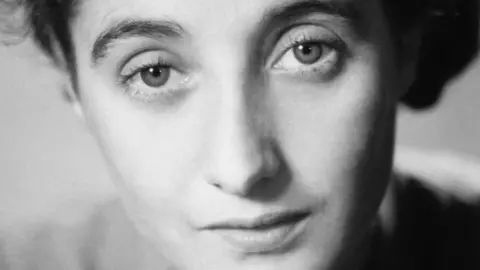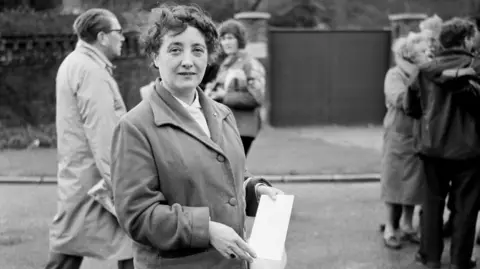Campaigning councillor celebrated in documentary
 Oxfordshire History Centre
Oxfordshire History CentreThe life of a campaigning councillor credited with helping to break down class divides in Oxford is being celebrated in a new documentary.
Olive Gibbs, who died aged 77 in 1995, twice served as the city's lord mayor, was an influential voice in the anti-nuclear weapons movement and fought to save community assets.
She also supported the 1950s demolition of Oxford's infamous Cutteslowe Walls, which had spikes on top and separated a council estate from private housing.
The documentary is called Olive Gibbs: A Remarkable Woman and will be screened at St Barnabas Church in Jericho on Saturday.
Christopher Baines, who made the film alongside Helen Sheppard, told the BBC they were inspired to make the documentary after seeing a photography exhibition about her at Weston Library in 2021.
"She had the most incredible face staring out of a photograph," he recalled.
"We decided to look into her life and discovered she had the most amazing story."
 Christopher Baines
Christopher BainesThey collected material and memories from her sons, residents and local historians.
The documentary is told through her own voice using an interview recorded in the 1960s found when her sons gave them "huge boxes full of photographs, family albums and letters",
"She was twice a popular and well respected Lord Mayor of Oxford, a peace campaigner and the first woman chair of the Campaign for Nuclear Disarmament (CND)," Mr Baines said.
Mr Baines said the Labour councillor's influence on bringing down the Cutteslowe Walls was also an important part of her legacy.
They were built in 1934, were over 6ft 6ins (2m) high and topped with lethal spikes.
They divided the city council's Cutteslowe estate from private housing to the west that was developed by Clive Saxton of the Urban Housing Company.
Mr Saxton was afraid his housing would not sell if so-called "slum dwellers" were going to be neighbours, and the walls were built to separate them.
 Mirrorpix
MirrorpixThe council made numerous efforts to bring the walls down, but it was not until 1959 when Gibbs and her councillor husband Edmund finally succeeded in leading the fight to get them removed.
She was also credited with saving Oxford neighbourhood Jericho from demolition and helping to thwart plans for a motorway to be built through Christ Church Meadow, leading to her being expelled from the Labour group on the council.
She was made an Honorary Freeman of Oxford, a Deputy Lieutenant of Oxfordshire and received the Frank Cousins’ Peace Award for her work as a founding member of the CND.
Mr Baines said Gibbs also talked about the environment when "it really wasn't nearly as popular a word is it is now", as well as her struggles with depression "at a time when it really wasn't the normal thing to do".
But it was her "incredibly warm character" that had inspired them to make the documentary, he said.
"She had a passion throughout her life for Oxford from the people of Oxford," he said.
You can follow BBC Oxfordshire on Facebook, X (Twitter), or Instagram.
